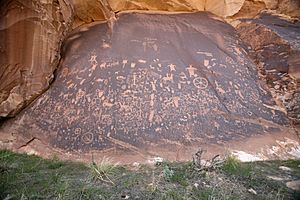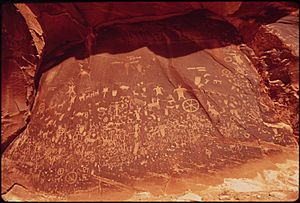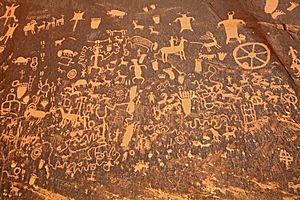Newspaper Rock State Historic Monument facts for kids
Quick facts for kids Newspaper Rock |
|
|---|---|
| Indian Creek State Park | |

Newspaper Rock in 2009
|
|
| Type | Petroglyph |
| Location | 20 Mi. SE of Canyonlands at Newspaper Rock State Park |
| Nearest city | Monticello |
| Area | Canyonlands NP |
| Elevation | 6080 ft |
| Owner | Utah State Parks Commission |
| Official name: Newspaper Rock State Historic Monument | |
| Designated | March 15, 1976 |
| Reference no. | 76001833 |
Newspaper Rock State Historic Monument is a special place in Utah. It has a large rock covered with hundreds of ancient carvings called petroglyphs. Think of it like a giant outdoor art gallery!
This amazing rock is found in San Juan County, Utah. It's about 28 miles (45 km) northwest of Monticello and 53 miles (85 km) south of Moab. You can find it along Utah State Route 211, which is a road that leads to the Needles area of Canyonlands National Park.
The rock itself is huge, about 200 square feet (18.5 square meters) in size. It's part of tall sandstone cliffs in Indian Creek Canyon. The carvings on it are some of the biggest and best-kept groups of petroglyphs in the southwestern United States. They show a mix of people, animals, objects, and abstract shapes.
Newspaper Rock became a State Historical Monument in 1961. Later, in 1976, it was added to the National Register of Historic Places as part of Indian Creek State Park.
What are the Newspaper Rock Petroglyphs?
The first carvings on Newspaper Rock were made around 2,000 years ago. Different groups of people added to them over time. These groups include the Archaic, Anasazi, Fremont, Navajo, and Pueblo cultures. Even some early Anglo settlers added their marks.
In the Navajo language, the rock is called "Tse' Hone'". This name means "a rock that tells a story." It's a perfect name because the carvings really do seem to tell stories from the past.
There are more than 650 different designs carved into the rock. You can see pictures of animals like deer, buffalo, and pronghorn antelope. Some carvings even show people riding horses. Many images seem to record past events, much like a newspaper would.
Scientists can't say exactly when each carving was made. However, they can tell which ones are older by looking at how dark they are. The older carvings have a darker coating on them.
How Were the Petroglyphs Made?
The pictures at Newspaper Rock were carved into a dark layer on the rock's surface. This layer is called "desert varnish." Desert varnish is a blackish coating that slowly forms on exposed sandstone cliffs. It's made by rain and tiny living things called bacteria.
Ancient artists created the carvings by carefully pecking at the rock with sharp tools. This removed the dark desert varnish and showed the lighter rock underneath. Over time, new desert varnish slowly forms on the older carvings, making them darker again. This is how we can tell which carvings are the oldest.
Images for kids




